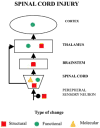Neural plasticity after spinal cord injury
- PMID: 15853674
- PMCID: PMC3562709
- DOI: 10.2174/1381612053507855
Neural plasticity after spinal cord injury
Abstract
Spinal cord injury (SCI) has devastating physical and socioeconomical impact. However, some degree of functional recovery is frequently observed in patients after SCI. There is considerable evidence that functional plasticity occurs in cerebral cortical maps of the body, which may account for functional recovery after injury. Additionally, these plasticity changes also occur at multiple levels including the brainstem, spinal cord, and peripheral nervous system. Although the interaction of plasticity changes at each level has been less well studied, it is likely that changes in subcortical levels contribute to cortical reorganization. Since the permeability of the blood-brain barrier (BBB) is changed, SCI-induced factors, such as cytokines and growth factors, can be involved in the plasticity events, thus affecting the final functional recovery after SCI. The mechanism of plasticity probably differs depending on the time frame. The reorganization that is rapidly induced by acute injury is likely based on unmasking of latent synapses resulting from modulation of neurotransmitters, while the long-term changes after chronic injury involve changes of synaptic efficacy modulated by long-term potentiation and axonal regeneration and sprouting. The functional significance of neural plasticity after SCI remains unclear. It indicates that in some situations plasticity changes can result in functional improvement, while in other situations they may have harmful consequences. Thus, further understanding of the mechanisms of plasticity could lead to better ways of promoting useful reorganization and preventing undesirable consequences.
Figures



Similar articles
-
Nervous system reorganization following injury.Neuroscience. 2002;111(4):761-73. doi: 10.1016/s0306-4522(02)00025-8. Neuroscience. 2002. PMID: 12031403 Review.
-
Intervention strategies to enhance anatomical plasticity and recovery of function after spinal cord injury.Adv Neurol. 1997;72:257-75. Adv Neurol. 1997. PMID: 8993704 Review.
-
Reticulospinal plasticity after cervical spinal cord injury in the rat involves withdrawal of projections below the injury.Exp Neurol. 2013 Sep;247:241-9. doi: 10.1016/j.expneurol.2013.05.003. Epub 2013 May 17. Exp Neurol. 2013. PMID: 23684634
-
Plasticity of motor systems after incomplete spinal cord injury.Nat Rev Neurosci. 2001 Apr;2(4):263-73. doi: 10.1038/35067570. Nat Rev Neurosci. 2001. PMID: 11283749 Review.
-
Synaptic plasticity, neurogenesis, and functional recovery after spinal cord injury.Neuroscientist. 2009 Apr;15(2):149-65. doi: 10.1177/1073858408331372. Neuroscientist. 2009. PMID: 19307422 Free PMC article. Review.
Cited by
-
Immersive virtual reality for chronic neuropathic pain after spinal cord injury: a pilot, randomized, controlled trial.Pain Rep. 2024 Oct 8;9(6):e1173. doi: 10.1097/PR9.0000000000001173. eCollection 2024 Dec. Pain Rep. 2024. PMID: 39391768 Free PMC article.
-
The role of the miR-99b-5p/mTOR signaling pathway in neuroregeneration in mice following spinal cord injury.Mol Med Rep. 2017 Dec;16(6):9355-9360. doi: 10.3892/mmr.2017.7816. Epub 2017 Oct 17. Mol Med Rep. 2017. PMID: 29039596 Free PMC article.
-
Intensity dependent effects of transcranial direct current stimulation on corticospinal excitability in chronic spinal cord injury.Arch Phys Med Rehabil. 2015 Apr;96(4 Suppl):S114-21. doi: 10.1016/j.apmr.2014.11.004. Epub 2014 Nov 22. Arch Phys Med Rehabil. 2015. PMID: 25461825 Free PMC article. Clinical Trial.
-
The Role of microRNA Markers in the Diagnosis, Treatment, and Outcome Prediction of Spinal Cord Injury.Front Surg. 2016 Nov 8;3:56. doi: 10.3389/fsurg.2016.00056. eCollection 2016. Front Surg. 2016. PMID: 27878119 Free PMC article. Review.
-
Exoskeletal-Assisted Walking During Acute Inpatient Rehabilitation Enhances Recovery for Persons with Spinal Cord Injury-A Pilot Randomized Controlled Trial.J Neurotrauma. 2024 Sep;41(17-18):2089-2100. doi: 10.1089/neu.2023.0667. Epub 2024 May 8. J Neurotrauma. 2024. PMID: 38661533 Clinical Trial.
References
-
- Fry EJ. Central nervous system regeneration: mission impossible? Clin Exp Pharmacol Physiol. 2001;28:253. - PubMed
-
- Burns SP, Golding DG, Rolle WA, Jr, Graziani V, Ditunno JF., Jr Recovery of ambulation in motor-incomplete tetraplegia. Arch Phys Med Rehabil. 1997;78:1169. - PubMed
-
- Waters RL, Adkins RH, Sie IH, Yakura JS. Motor recovery following spinal cord injury associated with cervical spondylosis: a collaborative study. Spinal Cord. 1996;34:711. - PubMed
-
- Blight AR. Remyelination, revascularization, and recovery of function in experimental spinal cord injury. Adv Neurol. 1993;59:91. - PubMed
-
- Little JW, Ditunno JF, Jr, Stiens SA, Harris RM. Incomplete spinal cord injury: neuronal mechanisms of motor recovery and hyperreflexia. Arch Phys Med Rehabil. 1999;80:587. - PubMed
Publication types
MeSH terms
Grants and funding
LinkOut - more resources
Full Text Sources
Other Literature Sources
Medical

